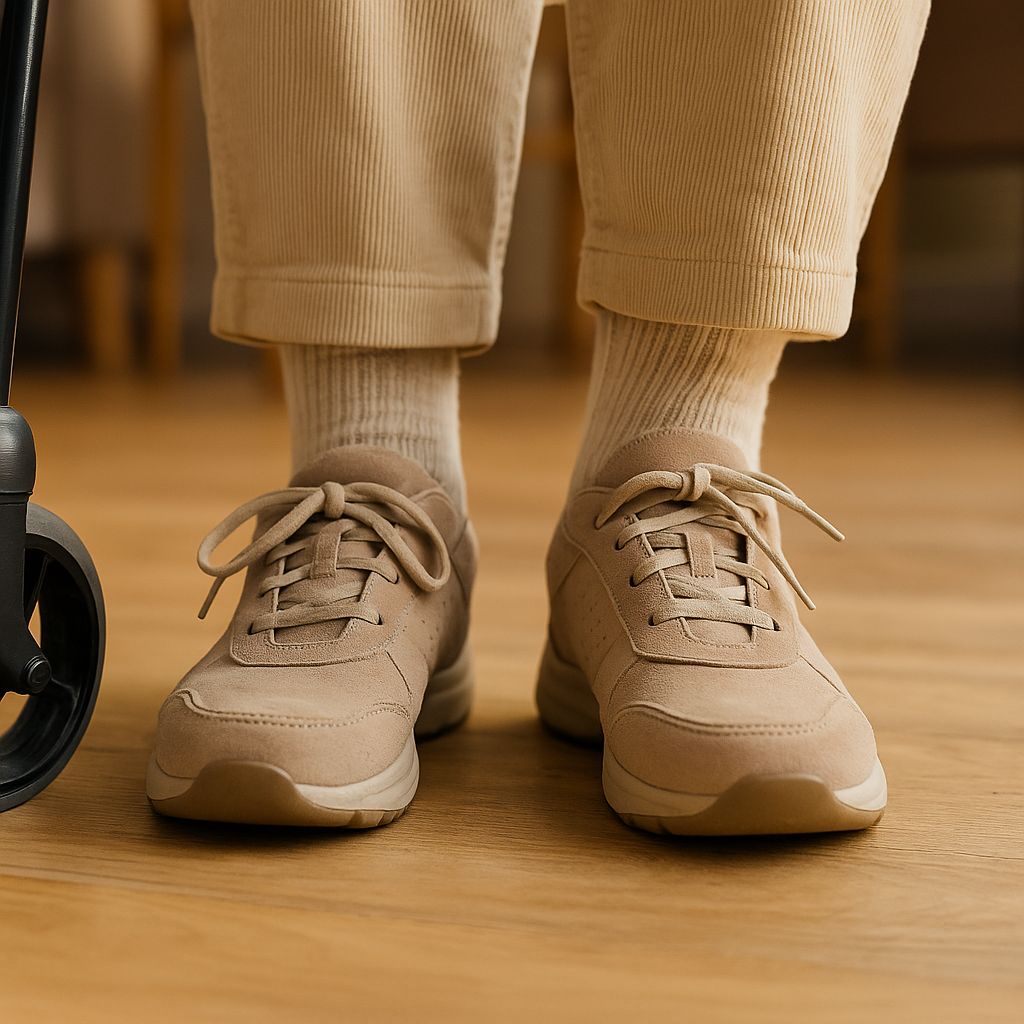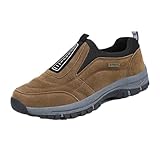Find the best stability and comfort shoes designed for balance, support, and pain-free walking. Step confidently with footwear that keeps you steady and comfortable.
Every confident step begins with comfort. When your shoes fit right, your body feels more balanced, your stride feels smoother, and your risk of slipping or stumbling drops dramatically.
find Stability and Comfort Shoes
In this stage of life, our feet naturally change — arches flatten, toes shift, and skin becomes more sensitive and Stability and Comfort Shoes. The right pair of shoes supports those changes rather than fighting them, helping you stay active, steady, and comfortable wherever life takes you.
Why Footwear Matters More Than Ever
It’s easy to underestimate the power of good shoes. But the truth is, poor footwear is one of the biggest hidden causes of falls among older adults.
Worn-out soles, slick bottoms, and flimsy slip-ons may feel easy to slide into, but they don’t offer the stability your body now depends on.
Supportive shoes, on the other hand, do much more than protect your feet — they help your whole body stay aligned and balanced.
🦶 Your feet are your foundation — treat them like the valuable support system they are.
Signs It’s Time for New Shoes
You might not think much about replacing your shoes, but your feet often tell the story before your eyes do.
Here’s what to watch for:
- Uneven or worn-out soles
- Heel slippage or loose fit
- Pain or pressure points after short walks
- Less traction on smooth floors
- Shoes that feel “off balance” when you stand still
If any of these sound familiar, it’s time for a supportive upgrade.
What Makes a Shoe Safe and Supportive
When choosing Stability and Comfort Shoes, look for a few key features:
1. Firm, Non-Slip Soles
A thick, rubber sole gives traction and absorbs shock. Avoid smooth bottoms that can skid on tile or hardwood floors.
2. Low, Stable Heel
Flat doesn’t always mean stable — instead, choose a low heel (under 1 inch) that supports your natural gait and keeps weight evenly distributed.
3. Adjustable Fit
Shoes with Velcro straps, laces, or elastic panels allow a secure fit that adapts to swelling throughout the day.
4. Wide Toe Box
Tight shoes can squeeze toes and affect balance. Look for a rounded shape that gives your toes room to move naturally.
5. Firm Heel Counter
This is the stiff area around the back of the shoe. It helps prevent wobbling and keeps your ankle aligned.
👟 Think of it as gentle structure, not stiffness. You want support without restriction.
Everyday Shoes That Work Well for Seniors
Here are the types of shoes most experts recommend for daily comfort and movement confidence:
- Walking shoes: Lightweight and cushioned, ideal for errands and exercise.
- Supportive sneakers: Great traction and flexibility for both indoor and outdoor use.
- Orthopedic shoes: Designed with built-in arch and heel support for all-day wear.
- Slip-resistant house shoes: A safer alternative to slippers, with soft soles that grip floors.
- Elastic or adjustable styles: Perfect for swelling feet or arthritis-friendly dressing.
If you prefer something stylish, there are now many senior-focused shoe brands offering attractive designs with hidden support features.
- Convenient Hook and Loop Design: Extra wide width diabetic shoes with adjustable design,it can be fully opened for easy…
- Wide Toe Box: These barefoot shoes are designed with a wide toe box allows your toes to move freely inside the shoes. A…
- Breathable Upper:Womens walking shoes made of high quality stretchy Knit Upper which has a good skin feeling and sweat…
- Zero-drop Design: Zero-drop, non-elevated sole design of the adjustable walking shoes ensures correct walking posture…
- 〓 Comfy wide width Shoes: Upgraded wide toe design keeps your toes in their natural shape without being squeezed….
- 〓 Adjustable Diabetic Shoes: The adjustable straps design meet the needs of different foot types and are ideal for…
- 〓 Lightweight Barefoot shoes: Stretchy upper with three-dimensional knitting gives maximum comfort and reduces…
- 〓 Zero Drop Walking Shoes: Thanks to one-piece molding process, the rubber sole with non-slip treads provides…
- SUPERIOR COMFORT AND SUPPORT: Ultra Go cushioning and Air-Cooled Goga Mat insole deliver exceptional comfort for mens…
- BREATHABLE DESIGN: Soft woven mesh upper with synthetic overlays keeps these men shoes ventilated and comfortable
- EASY SLIP-ON STYLE: Double gore stretch design makes these shoes for men easy to put on and ensures a secure fit
- DURABLE CONSTRUCTION: Dual-density rubber traction outsole provides stability and long-lasting wear for daily use
- 【All-Day Stability】Engineered with proprietary stability technology, these senior walking shoes for balance actively…
- 【Waterproof Armor for Active Lifestyles】Crafted with seam-sealed waterproof membrane, your feet stay desert-dry in…
- 【Wide Toe Box Relief System】Experience pressure-free comfort with our extra-depth toe box. The stretchable upper…
- 【Effortless Slip-On Convenience】Step in and go! The stretch collar and heel pull tab eliminate bending or laces….
House Slippers: Comfort with Caution
Many people love slippers for warmth, but traditional styles can be risky. Soft soles and loose fits can cause sliding or tripping on smooth floors.
If you enjoy wearing slippers, look for:
- Non-slip rubber soles
- Closed heels for a snug fit
- Firm cushioning for support
- Machine-washable materials for hygiene
🏠 Think of them as “indoor shoes,” not floppy slippers.
Custom Insoles and Orthotics
If you have chronic foot pain, bunions, or diabetes, talk to a podiatrist about custom insoles. These inserts can help correct foot alignment, ease pressure, and improve balance. They’re also great for cushioning sensitive joints like the knees and hips.
Even over-the-counter insoles can make a big difference if your shoes are otherwise supportive but lack soft padding.
Seasonal Footwear Tips
- In summer: Breathable mesh shoes keep feet cool without slipping.
- In winter: Choose boots with solid ankle support and traction grips.
- During rain: Use waterproof soles and removable inserts that dry quickly.
Avoid sandals without ankle straps — they may slip or twist while walking.
Caring for Your Shoes
Shoes, like tires, wear down gradually. Keeping them in good shape protects your safety and comfort.
- Rotate between two pairs to extend life.
- Wipe soles regularly to remove dust and oil buildup.
- Replace insoles every few months.
- Check for cracks, loose stitching, or worn tread.
If your shoes are more than a year old and you wear them daily, it’s probably time for a new pair.
When to Seek Help
If you find your balance worsening even with good shoes, it might not be your footwear alone. Foot pain, neuropathy, and circulation issues can all affect how you walk.
A podiatrist or physical therapist can evaluate your gait and recommend specialized shoes or inserts to restore comfort and confidence.
💬 You deserve shoes that fit both your feet and your lifestyle.
Final Thoughts
Safe, stable movement begins from the ground up. Choosing the right shoes isn’t vanity — it’s smart self-care. Comfort, traction, and proper fit work together to help you stay mobile, independent, and pain-free.
So next time you lace up, remember:
👟 Good shoes don’t just take you places — they help you stay on your feet for years to come.
Recommended Reading:
- Safe Movement at Home: Room-by-room tips to prevent slips and falls.
- Mobility Aid Choices: Find support tools that fit your daily life.
- Balance and Exercises: Simple routines that keep you strong and steady.
👟 Frequently Asked Questions
1. What kind of shoes help prevent falls?
Look for shoes with firm, non-slip soles, a low heel, and good ankle support. Avoid smooth or flexible bottoms that can slide easily on tile or wood floors. Stability shoes or walking sneakers with traction are ideal for everyday safety.
2. Are slip-on shoes safe for seniors?
Most slip-on shoes are too loose and can cause tripping. If you prefer the convenience, choose styles with stretchy sides or adjustable straps so they fit securely around your heel and ankle.
3. How often should I replace my shoes?
Shoes lose their support over time, even if they look fine. For daily wear, replace them about every 6–12 months. If you notice worn soles, uneven tread, or foot pain, it’s time for a new pair.
4. What are the best house shoes for seniors?
Choose closed-back slippers or house shoes with non-slip soles, firm cushioning, and a snug fit. Avoid open-heel slippers, which can slip off easily or cause you to trip.
5. Do orthopedic shoes really make a difference?
Yes. Orthopedic shoes are designed to support arches, cushion pressure points, and improve balance. They’re especially helpful if you have arthritis, bunions, or foot pain from diabetes or neuropathy.
6. Can I use insoles or inserts in regular shoes?
Absolutely. Over-the-counter insoles can add cushioning and improve fit, while custom orthotics from a podiatrist can correct posture and balance. Just make sure your shoes have removable insoles and enough depth to accommodate them.









